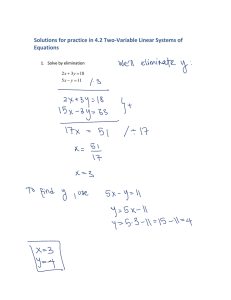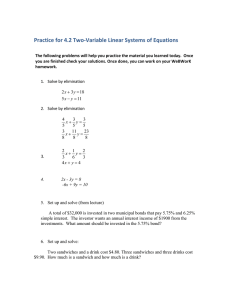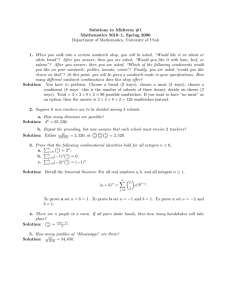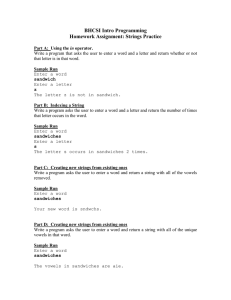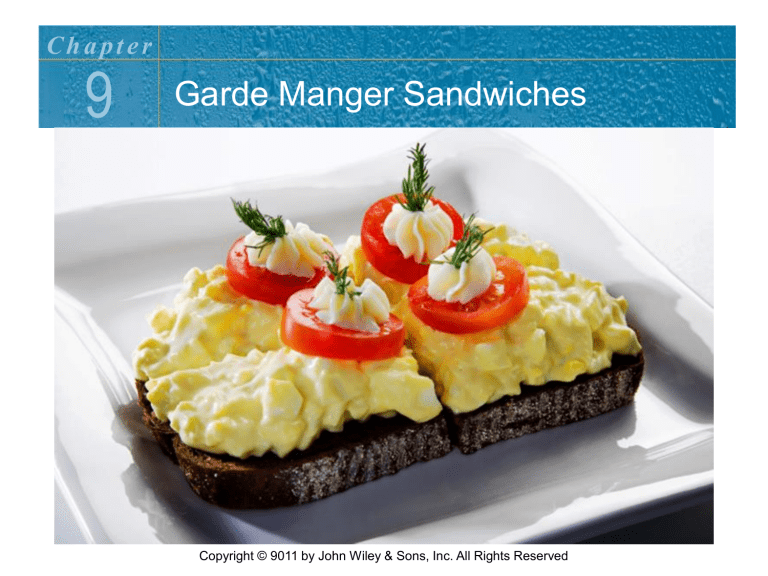
Chapter 9 Garde Manger Sandwiches Copyright © 9011 by John Wiley & Sons, Inc. All Rights Reserved Chapter 9 Garde Manger Sandwiches Chapter Pre-Requisites Before reading this chapter, you should already: • Have read “How to Use This Book,” pages xxviii-xxxiii, and understand the professional recipe format. • Have mastered the preparation of bound protein salads covered in Chapter 5. • Have mastered the preparation of cold meats and poultry covered in Chapter 7. • Know basic sanitation procedures for products served raw. • Know state and local regulations for foodservice glove use. Copyright © 9011 by John Wiley & Sons, Inc. All Rights Reserved Chapter 9 Garde Manger Sandwiches Chapter Objectives After reading this chapter, you should be able to: • Name the four elements of a basic sandwich, and explain the functions of each. • List and describe the six basic sandwich construction types, and explain the principles of sandwich construction. • Properly use the tools and equipment found in a modern sandwich station. • Become proficient at both plated and tray presentation of sandwiches. Copyright © 9011 by John Wiley & Sons, Inc. All Rights Reserved Chapter 9 Garde Manger Sandwiches Chapter Objectives After reading this chapter, you should be able to: • Correctly package sandwiches for box lunches and to-go service. • Set up and maintain an efficient sandwich station. • Correctly prepare the most popular North American cold sandwiches as well as the hot sandwiches typically prepared in the garde manger station. • Combine food items and ingredients to make successful new sandwich creations. Copyright © 9011 by John Wiley & Sons, Inc. All Rights Reserved Chapter 9 Garde Manger Sandwiches Understanding Sandwiches The Four Basic Sandwich Elements • Virtually all sandwiches are constructed from four basic elements: 1. 2. 3. 4. Bread Spread Filling Internal garnishes • Most modern sandwiches include all four basic elements, with the bread and filling acting as the essential elements. • However, without a spread, most sandwiches have a dry mouthfeel; without internal garnishes, they lack textural contrast. Copyright © 9011 by John Wiley & Sons, Inc. All Rights Reserved Chapter 9 Garde Manger Sandwiches Understanding Sandwiches Bread for Sandwiches • The majority of sandwiches are made with leavened breads, which are made with yeast. • Because unleavened breads do not contain yeast to make them rise, they have a flat shape and are also called flatbreads. • Some leavened breads are fabricated to give them a flat appearance as well—these are called yeasted flatbreads. Copyright © 9011 by John Wiley & Sons, Inc. All Rights Reserved Chapter 9 Garde Manger Sandwiches Understanding Sandwiches Bread for Sandwiches • The primary function of bread as a sandwich element is to encase the filling and enable it to be eaten neatly out of hand. • The bread product you choose for sandwich making must fulfill five requirements: 1. 2. 3. 4. 5. Firm and sturdy enough to hold the filling without falling apart. Tender and moist enough to avoid making the sandwich tough or dry. Fresh, not stale or dried out. Priced to fit your budget. Shaped and sized to ensure proper portion control and minimal waste. Copyright © 9011 by John Wiley & Sons, Inc. All Rights Reserved Chapter 9 Garde Manger Sandwiches Understanding Sandwiches Bread Market Forms • Breads are classified into four basic market forms: 1. Industrial bread products 2. Commercial bread products 3. Frozen par-bake bread products 4. Artisan bread products Copyright © 9011 by John Wiley & Sons, Inc. All Rights Reserved Chapter 9 Garde Manger Sandwiches Understanding Sandwiches Breads by Flour Type and Flavor • Breads are primarily classified according to the type of flour from which they are made. • Once that classification is determined, breads can also be categorized by non-flour flavorings added to the dough. Bread Fabrication Types • Breads can be shaped or formed in hundreds of ways. Copyright © 9011 by John Wiley & Sons, Inc. All Rights Reserved Chapter 9 Garde Manger Sandwiches Understanding Sandwiches Guidelines for Storing Sandwich Bread and Rolls • To prevent drying, do not store any bread product near heat-producing equipment (i.e., ovens or refrigeration compressors). • To prevent rapid staling, do not store any bread product in the refrigerator. • Inspect for mold before each service. Copyright © 9011 by John Wiley & Sons, Inc. All Rights Reserved Chapter 9 Garde Manger Sandwiches Understanding Sandwiches Guidelines for Storing Soft-crusted Bread and Rolls • Store soft-crusted breads and rolls wrapped in plastic film or in sealed plastic bags at cool room temperature— do not store in a dark, closed cabinet. • If soft-crusted bread products must be kept longer than 1–2 days, wrap tightly and freeze. – Place in sealed plastic bags as soon as they are completely thawed. – Do not refreeze. Copyright © 9011 by John Wiley & Sons, Inc. All Rights Reserved Chapter 9 Garde Manger Sandwiches Understanding Sandwiches Guidelines for Storing Crisp-crusted Bread and Rolls • Store crisp-crusted bread products intended for sameday service at cool room temperature. – Keep in micro-perforated bags specially manufactured to prevent drying and surface contamination while allowing moisture to escape. – Alternatively, store in closed cartons or in open plastic containers covered with kitchen towels. Copyright © 9011 by John Wiley & Sons, Inc. All Rights Reserved Chapter 9 Garde Manger Sandwiches Understanding Sandwiches Guidelines for Storing Crisp-crusted Bread and Rolls • If crisp-crusted bread products must be kept for longer periods, wrap tightly and freeze. – Thaw frozen bread products unwrapped on a rack at room temperature. – Once they are completely thawed and free of surface moisture, immediately proceed with wrapping or recrisping. • To recrisp crisp-crusted breads and rolls: – Place them on a rack set on a sheet tray and bake in a preheated 400°F (200°C) oven, just until the crusts regain their original crispness and the bread reaches an interior temperature of 140°F (60°C). – Cool to room temperature on the rack. Copyright © 9011 by John Wiley & Sons, Inc. All Rights Reserved Chapter 9 Garde Manger Sandwiches Understanding Sandwiches Spreads for Sandwiches • A sandwich spread is a liquid or paste-like dressing usually applied to the bread element of the sandwich. • Sandwich spreads are intended to fulfill several functions: 1. Form a liquid-resistant barrier that prevents a moist filling from seeping into the bread and making it soggy. 2. Add moisture and a rich, smooth mouthfeel to sandwiches having less moist fillings. 3. Help the sandwich hold together by acting as a kind of glue, binding the bread, filling, and internal garnishes to one another. Copyright © 9011 by John Wiley & Sons, Inc. All Rights Reserved Chapter 9 Garde Manger Sandwiches Understanding Sandwiches Spreads for Sandwiches • Sandwich spreads are intended to fulfill several functions (cont’d): 4. Add a particular flavor or combination of flavors to the sandwich. 5. Add a particular color to the sandwich’s visual effect. 6. In à la carte service, the choice of spread is often left to the customer, who specifies it when ordering. • There are some classic sandwiches in which a particular spread, such as mayonnaise on a BLT or Russian dressing on a corned beef special, is dictated by tradition. Copyright © 9011 by John Wiley & Sons, Inc. All Rights Reserved Chapter 9 Garde Manger Sandwiches Understanding Sandwiches Spreads for Sandwiches • Types of Spreads – – – – – – – Butter Mayonnaise Prepared Mustards Cheese Spreads Vegetable Purées and Fresh Salsas Ketchups, Relishes, and Processed Salsas Flavored Oils and Vinaigrettes Copyright © 9011 by John Wiley & Sons, Inc. All Rights Reserved Chapter 9 Garde Manger Sandwiches Understanding Sandwiches Sandwich Fillings • The filling is the heart of the sandwich and is considered its main ingredient. • A sandwich filling may consist of a single ingredient or a combination of ingredients. • Deli Meats – The most widely used sandwich fillings in North America are industrially processed deli meats. Copyright © 9011 by John Wiley & Sons, Inc. All Rights Reserved Chapter 9 Garde Manger Sandwiches Understanding Sandwiches Sandwich Fillings • House-Made Cooked Meats and Poultry – There are several advantages to preparing sandwich meats from scratch. – By choosing from the full range of raw products, you can offer unusual fillings, such as roast lamb or grilled duck. • Bacon – Bacon makes three important contributions to a cold sandwich: 1. 2. 3. Cooked crisp; it adds textural interest. High in fat; it adds richness. Its salty flavor; it helps season the sandwich. Copyright © 9011 by John Wiley & Sons, Inc. All Rights Reserved Chapter 9 Garde Manger Sandwiches Understanding Sandwiches Sandwich Fillings • Cheese – Any of the semisoft and firm cheeses may be sliced and used as sandwich fillings, either alone or in combination with other ingredients. – Deli cheeses are specially fabricated for use on an electric slicing machine. • Seafood – Smoked and cured seafood is featured in some sandwiches, particularly in small sandwiches such as canapés. Copyright © 9011 by John Wiley & Sons, Inc. All Rights Reserved Chapter 9 Garde Manger Sandwiches Understanding Sandwiches Sandwich Fillings • Bound Protein Salads – Salads made from meats, poultry, and seafood bound with a thick mayonnaise dressing are among the most popular sandwich fillings in North America. • Vegetable and Vegetarian Fillings – Today, most delis, sandwich shops, and restaurants offer a respectable selection of meatless sandwich fillings. Copyright © 9011 by John Wiley & Sons, Inc. All Rights Reserved Chapter 9 Garde Manger Sandwiches Understanding Sandwiches External and Internal Garnishes • External garnish: A piece of food served outside the sandwich rather than included inside it. • Internal garnish: Part of the sandwich that is enclosed within the bread (except in open-face sandwiches made with a single bread slice). • In North America, the most common internal sandwich garnishes are lettuce leaves and tomato slices, although there are many others. Copyright © 9011 by John Wiley & Sons, Inc. All Rights Reserved Chapter 9 Garde Manger Sandwiches Types of Sandwiches Sandwiches can be categorized into six basic construction types: 1. Simple sandwiches 2. Double-decker and multi-decker sandwiches 3. Open-face sandwiches 4. Long roll sandwiches 5. Pocket sandwiches 6. Wrap sandwiches Copyright © 9011 by John Wiley & Sons, Inc. All Rights Reserved Chapter 9 Garde Manger Sandwiches Types of Sandwiches Sandwiches can be categorized into six basic construction types: 1. Simple sandwiches – A simple sandwich that consists of two slices of bread with the spread, filling, and internal garnishes between them. 2. Double-Decker sandwiches – A sandwich having one deck, then another layer of filling on top of the ceiling slice, and finally a third slice of bread on top. Copyright © 9011 by John Wiley & Sons, Inc. All Rights Reserved Chapter 9 Garde Manger Sandwiches Types of Sandwiches Sandwiches can be categorized into six basic construction types: 3. Open-Face Sandwiches – A sandwich with a single slice of bread topped with a spread, filling ingredients, and garnishes. – In other words, an open-face sandwich is a sandwich with no lid. Copyright © 9011 by John Wiley & Sons, Inc. All Rights Reserved Chapter 9 Garde Manger Sandwiches Types of Sandwiches Sandwiches can be categorized into six basic construction types: 4. Long Roll Sandwiches – Sandwiches made with long, narrow French and Italian breads can be constructed in two different ways. 1. Simple long roll sandwich: the rolls are split completely in half horizontally and then filled. 2. Hollowed long roll sandwich: the roll is slit along one side, opened out, and flattened into a canoe shape. – The Italian Sandwich is probably the best-known long roll sandwich. Copyright © 9011 by John Wiley & Sons, Inc. All Rights Reserved Chapter 9 Garde Manger Sandwiches Types of Sandwiches Sandwiches can be categorized into six basic construction types: 5. Pocket Sandwiches – Sandwiches made with yeasted flatbreads that are fabricated and baked in a way that gives them a hollow center. 6. Wrap Sandwiches – Thin, pliable flatbreads may be rolled with or around a filling and internal garnishes to make wrap sandwiches. – There are two ways to roll wraps: 1. Pinwheel-style 2. Burrito-style Copyright © 9011 by John Wiley & Sons, Inc. All Rights Reserved Chapter 9 Garde Manger Sandwiches Making Sandwiches The Sandwich Station • In small operations with varied menus, there is usually only one garde manger area responsible for salads and cold appetizers, as well as sandwiches. • In large operations, an entire station may be dedicated to sandwiches. • Sandwiches are the main menu items in delis and sandwich shops, so the stations in them are planned expressly for sandwich production. Copyright © 9011 by John Wiley & Sons, Inc. All Rights Reserved Chapter 9 Garde Manger Sandwiches Making Sandwiches Mise-en-Place • A well-planned and complete mise en place is essential for effective à la carte sandwich service. • Sandwiches are usually ordered during lunch service, when most customers have limited time; in addition, customers perceive them to be quick to order. • Well-prepared garde manger chefs ensure that the time between the order and arrival of food at the table is brief. Copyright © 9011 by John Wiley & Sons, Inc. All Rights Reserved Chapter 9 Garde Manger Sandwiches Making Sandwiches Guidelines for Preparing Sandwiches • Slice enough deli meats and cheeses for the day’s service. – Portion fillings ahead of time. – Place the proper portion scoops near containers of bound protein salad. • Clean and fabricate all garnishes. – When fabricating items portioned by count, make sure each is of the correct size. – Pre-portion when possible. • Prepare all spreads and place in appropriate containers. – Place oils and semi liquid spreads in multi tip squeeze bottles. – Whip or soften butters and semisolid spreads. • Slice breads and rolls. Copyright © 9011 by John Wiley & Sons, Inc. All Rights Reserved Chapter 9 Garde Manger Sandwiches Making Sandwiches Guidelines for Preparing Sandwiches • Arrange ingredients in assembly-line fashion. – Place items in such a way that you can use two hands at the same time. • Use color-coded sandwich picks or other appropriate markers to identify orders. – For example, you could use yellow frill picks for a ham sandwich with mustard and clear frill picks for one with mayonnaise. • Have plates, baskets, wrappers, or take-out containers at hand. Copyright © 9011 by John Wiley & Sons, Inc. All Rights Reserved Chapter 9 Garde Manger Sandwiches Making Sandwiches Packaging Sandwiches for Take-out and Catering • Sandwiches are ordered to-go more often than any other type of food. • As sandwiches must be neat and easy to eat, it is crucial that they arrive at their destination in good shape. • Even the most delicious sandwich is ruined if it falls apart while being transported. • Customers do not appreciate soggy, oily wrappers and leaky condiment containers. Copyright © 9011 by John Wiley & Sons, Inc. All Rights Reserved Chapter 9 Garde Manger Sandwiches Making Sandwiches Packaging Sandwiches for Take-out and Catering • Wrapped Sandwiches – Most take-out sandwiches are wrapped in a paper product. – Tight wrapping holds sandwiches together, even if they are jostled during transport. • Box Lunch Sandwiches – The main element of most box lunches is some sort of cold sandwich. – Most sandwiches for box lunches are prepared and wrapped in the same way as for take-out, but with the condiment packets on the side to avoid a soggy sandwich. Copyright © 9011 by John Wiley & Sons, Inc. All Rights Reserved Chapter 9 Garde Manger Sandwiches Making Sandwiches Packaging Sandwiches for Take-out and Catering • Sandwich Trays – For catering, sandwiches are arranged on durable or disposable trays in an attractive presentation. – For successful sandwich trays, it is essential to construct the sandwiches neatly and securely. – Plan sandwich trays to consist of an assortment that will suit virtually all guests. Copyright © 9011 by John Wiley & Sons, Inc. All Rights Reserved Chapter 9 Garde Manger Sandwiches Making Sandwiches Guidelines for Sandwich Sanitation • Wear food-service gloves when preparing sandwiches. (Change gloves frequently.) • Do not allow a counterperson making sandwiches to handle money. • Wipe knives with sanitizer solution between each task. • Keep perishable fillings, spreads, and garnishes refrigerated during the service. • Keep lids of the sandwich/salad units closed when not in active use. • Regularly wash and sanitize the tops of squeeze bottles after each service, at least once per week. Copyright © 9011 by John Wiley & Sons, Inc. All Rights Reserved
